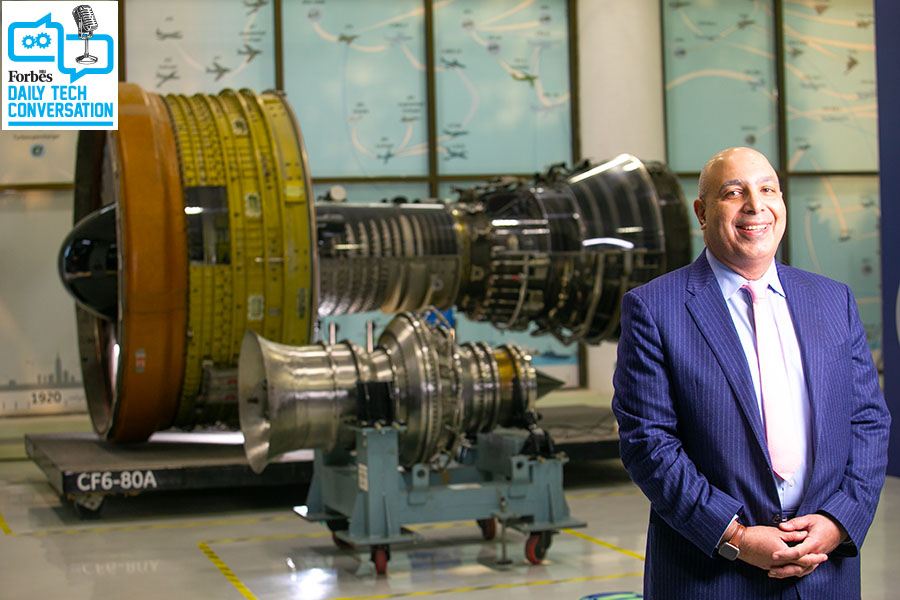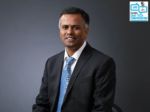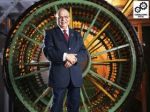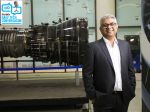
'Our India team is very much at the heart of our sustainability efforts': Mohamed Ali
GE Aerospace has big plans for its Indian operations, from R&D to manufacturing for the world, says Mohamed Ali, its vice president of engineering. And the company's 1,200 strong team in India is deep into making its next generation engines
 Mohamed Ali, vice president of engineering at GE Aerospace
Mohamed Ali, vice president of engineering at GE Aerospace
Mohamed Ali, vice president of engineering at GE Aerospace, recently appeared on Forbes India’s The Daily Tech Conversation. Ali, who is sometimes described as the person responsible for over 30,000 aircraft engines, spoke about the globally integrated role the company’s India team plays. Edited excerpts:
Q: What do you see in India as an aviation market today, and from your talent base perspective?
I hired some of the first employees at the John F Welch Technology Center [in Bengaluru]. So I feel I had a hand, even though it might be a small hand, in building and nurturing the site here. I also love to interact with the people, the technology they are developing.
And you go where the action is happening, and a lot of action is happening here, and I am where the action is.
India has a large pool of talented engineers, and the country has been producing some of the best graduates globally. Over the years, I have witnessed the growth and development of this talent first-hand. Initially, there were challenges, such as time differences and cultural differences, but now India has evolved to become a key player in aviation engineering.
The Indian team is actively involved in design, service, and technology development for widebody engines. They also provide support to customers worldwide, including in the Middle East, and contribute to the development of innovative solutions. Additionally, they are engaged in services and technologies that aid in predicting and mitigating the impact of dust on engines, utilising artificial intelligence and analytics.
Looking ahead, the aviation industry will continue to thrive due to the innate desire people have to fly. Advances in technology and affordable travel options have made flying more accessible to a wider population. However, sustainability is a pressing concern for both the industry and the planet.
Q: Tell us about your approach to sustainability and the Rise programme.
In 2021, despite the challenges posed by Covid-19, we made a significant announcement in Paris with our Safran CFM partners. We introduced the RISE programme, which stands for Revolutionary Innovations for Sustainable Engines. This programme reflects our belief that incremental progress alone is not enough to achieve a sustainable future.
The Rise programme is not solely focussed on creating a specific product, but rather on nurturing and advancing technologies that we will demonstrate and test in-flight by the middle of this decade. This will allow us to identify and implement the most effective sustainable solutions for future products. While our efforts [by themselves] may not achieve net-zero emissions by 2050, they will significantly reduce our reliance on increasingly expensive fuels, such as sustainable aviation fuel, hydrogen, or taxed fossil fuel.
In addition to sustainable aviation fuel and hydrogen, we are actively involved in hybrid electric development and collaborating with Nasa in this area. Our team in India plays a fundamental role in the Rise programme, as well as in the development of hybrid electric and hydrogen technologies. They are vital contributors to building and innovating these critical technologies for the future.
Achieving sustainability goals requires collaboration, not only within GE and CFM, but also with government partners, the entire industry, and the complete supply chain.
During my discussions and reviews with the team in India, I witnessed their active participation in Rise, the hybrid electric programme, and hydrogen development. Their commitment to these initiatives reflects our collective determination to create a sustainable future.
Also read: Skyroot Aerospace: Lift off, and how
Q: Why is a 20 percent performance improvement revolutionary in aviation terms?
Well, traditionally the best that has happened from one generation to the next is 10 to 15 percent. And, more recently, it's becoming increasingly hard with the current architecture to gain that, let alone increase over that. And therefore you just need to have a step function in that.
And we targeted 20 percent. We are actually trying to achieve more. Okay, but that's how you measure it relative to previous technological innovations. We are kind of doubling the speed of doing it. Now people might argue, why aren't you quadrupling? We will try. But there is also a balance of maturing that technology. It takes time to do that.
Realising that safety is the number one goal that we have as well. So, we have to let these technologies mature properly in the right time frame in order for all of us to lift people up and bring them home safely.
Q: Tell us about some of the aspects of the engine that you’ve said are less talked about, while the open fan tech gets much attention.
I mean, certainly the open fan obviously grabs all the attention and I cannot actually speak enough about how significant that is. And some people argue, well, GE has done an open fan demonstration 30 years ago, perhaps more, 35 years ago. What's new? And this is kind of like saying, well, but Thomas Edison worked on an electric car at the beginning of the previous century. What's new? Why are we talking about electric cars now?
The initial open fan, back in the 1980s, were counter rotating fans. So, two fans, extremely complicated. And the idea for that is to actually just maintain the forward velocity of the aircraft and pressurise the fan. What is new is the massive usage of supercomputers. We are one of the largest users of supercomputers in the world and it enabled us to say we actually don't need counter rotating fans.
We actually can go with only one fan, which now simplifies it significantly and we can balance in the open fan, which was very noisy, and supercomputers enabled us to learn that we can actually make a design that is beating today's noise standards and we are thrilled about that and still maintaining a fuel burn advantage.
Now let’s talk about what’s behind it. There are lots of technologies in that core. Just to imagine, what we are putting is a core that's the size of a business jet core. So, a tiny core that's now powering a 30,000 to 35,000 pound thrust engine that's powering a fan the size of a GE9X fan that goes on the 777; that is massive by itself.
Now what we are doing is we are taking the technologies from supercomputers and also putting it inside the core and that's enabling us to innovate shapes of air foils, that quite honestly, you look at them and you say, oh my God, this is impressive.
But, that's by itself. You can imagine all kinds of air foil shapes, but if you can't make them, then they're not going to go anywhere. And I think that's another revolution that's happening that people don't talk enough about.
And there are actually two more aspects related to manufacturing technologies. One of them is additive. And additive is enabling us to innovate all kinds of complex shapes that people would never have thought possible to manufacture in the past. And the second is ceramic matrix composite. And today GE is the only company, together with our partners Safran and CFM, to be flying engines with additive and also with ceramic matrix composites.
And the combination of additive and ceramics is actually enabling us to manufacture shapes and geometries with material capabilities that would have been only a dream a few years ago. So, we are really excited about the combination of all of these technologies. And you can tell we are not leaving any lever that we are not pulling to achieve that sustainable future.
Q: What are your immediate top priorities in India over 12 to 18 months?
The top priorities for the India team is to align with our overall goals. Ensuring the safety of our passengers and delivering high-quality products to our customers are paramount. I'm particularly proud of our manufacturing capabilities in India.
Over the past five years, our manufacturing in India has grown 20-fold, and we continue to see this growth. Significant components of our Leap engine are already being produced in India, and we are thrilled about this accomplishment. We anticipate further expansion in the future, with our team here providing ongoing support.
Our multimodal factory in Pune not only handles outsourcing but also manufactures significant components. This is not just for India but for the entire world. We take pride in this because it creates a cycle where engineers learn by engaging with the hardware and gaining field experience. They also visit our MRO facility in Malaysia to witness the service aspect. This continuous learning process helps them become better engineers.
Regarding India becoming an export hub for aircraft engines for GE, I believe it is within reach. India is already involved in manufacturing parts for our advanced engines. As a global company with a vast supply chain, competition is expected, and I am confident that India will excel.
I am genuinely passionate and excited about the potential of what India can achieve. The can-do attitude of the team at the Jack Welch Technology Center in India is their greatest asset. The sky is the limit for what they can accomplish, although I cannot predict specific timelines. But I firmly believe in the limitless potential of the team.


















